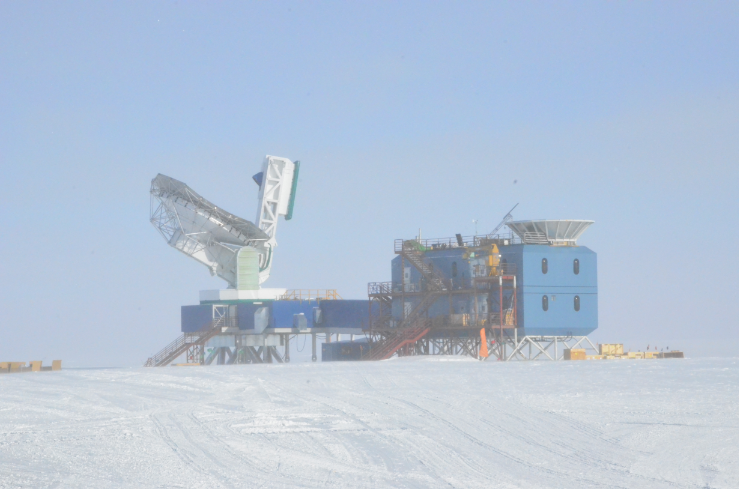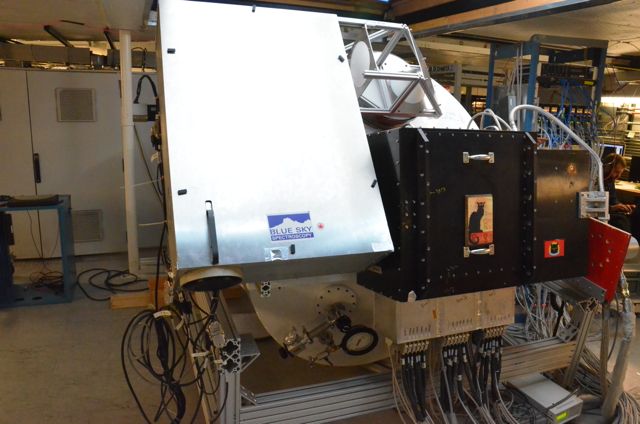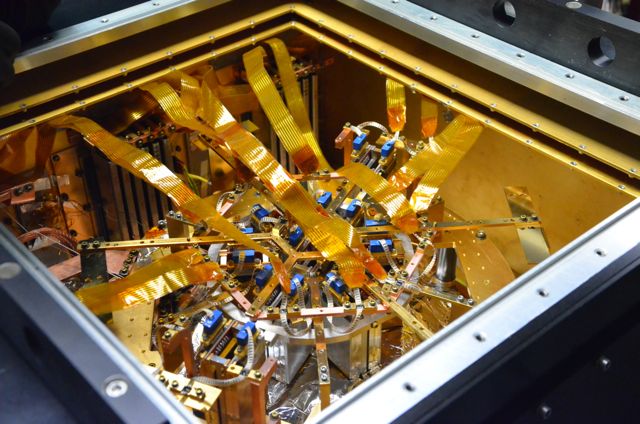Thursday, January 26. 2012
We started hoisting the optics/receiver cryostats into the telescope cabin at 9am on Jan 25, 2012. A mere 39 hours later at 11pm on Jan 26th we achieved first light with SPTpol! Below are detector timestreams as we scan across RCW38, one of the many calibration sources we use. In the next few weeks, we'll be working hard to characterize our instrument. We will make maps of calibration sources, characterize detector response and time constants, map our beams, get the telescope in really good focus for the winter, and measure our detector polarization angles. There is a lot to do to get ready for the observing season, but we're all really excited that we can see astrophysical objects with our new instrument! Congratulations and thanks to everyone who worked so hard to make this instrument possible. Stay tuned for updates!
Monday, January 23. 2012
Out receiver has been cold for a couple of days now, and we're starting to characterize its properties. Right now, we're using a Fourier Transform Spectrometer (FTS, http://en.wikipedia.org/wiki/Fourier_transform_spectroscopy) to measure the frequency response of the detectors. On the left, you can see the large, silver rectangle of the FTS mounted beside Black Cat on our optics cryostat. The cage on the upper right of the FTS, above Black Cat, takes the light emitted by the FTS and directs it into the cryostat window, where it can shine down on the receiver.
SPTpol has two kinds of detectors, one which is sensitive to light with frequencies near 90 GHz, and one which is sensitive to light with frequencies near 150 GHz. We chose those particular frequencies because 1) the CMB is (relatively) bright in those frequencies of light, 2) the atmosphere at the South Pole is transparent at those frequencies, and 3) the "shadow" which clusters of galaxies cast on the CMB (another kind of science that we're interested in) is most easily detectable at those frequencies. We use various filters to block out light with frequencies that we don't want to detect, and, before we start looking at the sky, we need to measure to be sure we know which light can get in, and which can't.
The FTS measurements are finishing up right now, and, when we're done, the next step will be to actually attach our brand-new receiver to the telescope. CMB, here we come!
Sunday, January 15. 2012
Early yesterday morning, the Black Cat cryostat was sealed up, hopefully for the last time this season. This is the third time that we've sealed up and cooled down. Cooling down the entire receiver from room temperature takes at least five days, so it's something that we can't do very often. We decided to warm up the receiver last time because it was getting too warm (where "too warm" means about 360 milli-Kelvin), which reduces the effectiveness of the sensors. We spent the time we had with the receiver warm doing everything we could to make sure it stays as cold as possible, as well as replacing some of the individual sensor elements which were broken or not as effective as they could be. Now we're done, and Black Cat is once again closed.
As you can see in the photograph below, Black Cat is now connected to the (larger, white) optics cryostat. The optics cryostat contains mirrors, lenses, and filters which transfer the light of the cosmic microwave background from the telescope dish down to Black Cat, where the light will eventually encounter the chilly bolometers which do the work of converting light into an electrical signal.
The first step in the cooldown is to pump all of the air out of the cryostats. We need to make sure that as little heat as possible can flow between the warm outside and the cold receiver inside the cryostat. Removing the air takes away a significant path for heat flow, and makes the cryostat much easier to cool. After the air is gone, we use a pulse-tube cooler (http://en.wikipedia.org/wiki/Pulse_tube_refrigerator) to cool the cryostat down to about 50 Kelvin, then two stages of further cooling which use the evaporation of liquid helium to cool the bolometers down to 300 milli-Kelvin.
If all goes well, the cryostats will remain in this cold vacuum (even colder than deep space) until next summer, when we perform more maintenance and upgrades.
Thursday, January 12. 2012
I realized that, while we posted a photograph of the new guard ring under construction (14 Dec 2011), we haven't yet posted a photograph of the finished product. Here it is.
The major thrust for this season is to install the new, polarization-sensitive receiver, but along with that, we've had to modify the telescope dish itself.
The polarization of the Cosmic Microwave Background is incredibly weak, so we need to be very careful about any Earthly sources which might add polarization to the light from the sky. We also need to prevent the glow from the warm ground from interfering with our view from the sky. Our old ground shield did a great job of this, but it also would have added some small polarization to the light that we measured. Hence, this guard ring.
This is the telescope in the docked position. From here, we can access the equipment which normally lives in the end of the boom, including the receiver itself. Note the blue tip of the new "snout" peeking up from the end of the boom.
Along with the new "snout" around our receiver, it keeps light from leaking around the outside of the dish and into our camera. With these changes, any polarization of the microwaves that we measure will actually be coming from the sky, and not from our telescope!
Monday, January 9. 2012
Today marks the arrival of the SPT's "night shift". Cynthia Chiang and Nicholas Huang completed the long trek to the South Pole, and will remain here throughout the long, cold polar night. No planes can fly in or out during the winter, so after the summer crew leaves next month, it will be up to our brave winterovers to operate and maintain the telescope until next November.
The entire crew is working hard to commission our new camera, so stay tuned for more updates!
|











